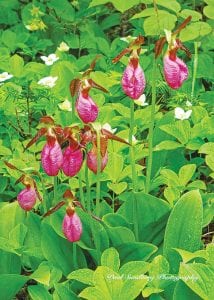Although the pink lady’s slipper (Cypripedium acaule) is not Minnesota’s State Flower—that honor was bestowed on the pink and white or showy lady’s slipper (Cypripedium reginae) in 1902— the wild pink orchid is a beloved sight in the Northland. Places where the lovely flowers grow are well-kept secrets, more closely guarded than a favorite fishing spot or blueberry patch. Sadly, a bed of lady’s slippers at Cascade River State Park has been destroyed.
Photographer Paul Sundberg of Grand Marais has returned to the state park for years to capture the rare flower in bloom. To Sundberg’s dismay, when he went to get pictures of this year’s blossoms last week, they were gone. Someone had dug them up.
“I was just sick when I saw the dirt hole where these beautiful flowers had been growing since the early 1970s. What a tragic thing for someone to do. There is no way they will live for whoever took them, but they robbed the beauty of these flowers from thousands of people forever,” said Sundberg.
According to the U.S. Forest Service, Sundberg is correct. In order to survive and reproduce, the pink lady’s slipper interacts with a fungus in the soil from the Rhizoctonia genus.
Generally, orchid seeds do not have food supplies inside them like most other kinds of seeds. Pink lady’s slipper seeds require threads of the fungus to break open the seed and attach them to it. The fungus passes nutrients to the pink lady’s slipper seed. When the lady’s slipper plant is older and producing most of its own nutrients, the fungus will extract nutrients from the orchid roots. This mutually beneficial relationship—symbiosis— is typical of almost all orchid species.
Pink lady’s slippers—sometimes known as the moccasin flower—take many years to go from seed to mature plants, according to the Minnesota Department of Natural Resources. Seed-bearing harvest of wild lady’s slipper root is not considered sustainable.
Not only does attempting to transplant lady’s slippers destroy a beautiful plant, since 1925, the wildflower has been protected by Minnesota state law. It is illegal to pick the flowers or to uproot or unearth them.
If someone really wants to try to grow lady’s slippers, they can be purchased from a nursery that specializes in native plants. If you purchase one, keep in mind that they need just the right conditions to grow successfully, replicating their natural habitat as closely as possible. They can be an expensive plant to purchase.
If you want to learn more about Minnesota orchids, the DNR recommends Orchids of Minnesota by Welby Smith, published by the University of Minnesota Press.



Loading Comments